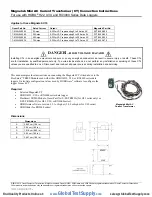
17
TK-390
1. Overview
The KENWOOD model TK-390 is a UHF/FM hand-held
transceiver designed to operate in the frequency range of
403 to 512MHz, the unit consists of a receiver, a transmit-
ter, a phase-locked loop (PLL) frequency synthesizer, power
supply circuits, a control unit.
2. Circuit Configuration by Frequency
The receiver is a double-conversion superheterodyne
with a first intermediate frequency (IF) of 44.85MHz and a
second IF of 455kHz. Incoming a signals from the antenna
are mixed with the local signal from the PLL to produce the
first IF of 44.85MHz.
This is then mixed with the 44.395MHz second local os-
cillator output to produce the 455kHz second IF. This is de-
tected to give the demodulated signal.
The transmit signal frequency is generated by the PLL
VCO, and modulated by the signal from the microphone. It
is then amplified and sent to the antenna.
3-2. First mixer
The 1st mixer uses the GaAs IC (IC200). The 1st mixer
mixes the signal with the 1st local oscillator frequency from
the VCO, and converts it to the 1st IF (44.85MHz).
The signal then passes through monolithic crystal filter
(XF301) to remove unnecessary nearby frequency compo-
nents. The signal from the MCF is used as the 1st IF signal.
3-3. IF amplifier
The 1st IF signal is amplified (Q302) and fed into IC300 in
the FM IF IC. The IF signal is then mixed with the 2nd local
oscillator frequency of 44.395MHz to generate the 2nd IF of
455kHz. The 455kHz signal is then passed through a ce-
ramic filter (CF300, CF301 ; Wide, CF302, CF303 ; Narrow)
and fed back into IC300 for additional amplification.
ANT
TX/RX
450~490MHz : K, K4
470~512MHz : K2
403~430MHz : K3, K6
ANT
SW
RF
AMP
PA
AMP
TX
AMP
1st MIX
MCF : 44.85MHz
XF301
CF
455kHz
CF300,301
: Wide
CF302,303
: Narrow
FM IF
SYSTEM
AF
AMP
SP
44.395MHz
405.15~445.15MHz : K, K4
425.15~467.15MHz : K2
358.15~385.15MHz : K3, K6
450~490MHz : K, K4
470~512MHz : K2
403~430MHz : K3, K6
PLL
VCO
MIC
AMP
MIC
Fig. 1
Frequency configuration
3. Receiver System
3-1. Front-end RF amplifier
The signal coming from the antenna passes through the
transmit/receive switching diode circuit, is amplified by the
RF amplifier (Q200), and passes through a BPF (L205). The
resulting signal is further amplified by the RF amplifier
(Q201), passes through a BPF (L210) and goes to the mixer.
The band-pass filters (L205 and L210) are two-pole helical
resonators that uses varactor diode tuning to reject un-
wanted signal components.
T/R
SW
Q200
RF AMP
L205
BPF
Q201
RF AMP
L210
BPF
IC200
1st MIX
D7
MCF
XF301
Q302
IF AMP
IC300
FM IF SYSTEM
X300
44.395
MHz
CF300,301
: Wide
CF302,303
: Narrow
ANT
SW
Fig. 2
Receiver section
Item
Rating
Nominal center frequency
44.85MHz
Pass band width
±
5~7kHz at 3dB
Attenuation band width
±
25kHz or less at 30dB
Ripple
1.0dB or less
Insertion loss
4dB or less
Guaranteed attenuation
80dB or more at fo
±
910kHz
40dB or more within fo
±
1MHz
Terminating impedance
350
Ω
/ 4.5pF
Table 1
Crystal filter XF301 (L71-0588-05)
CIRCUIT DESCRIPTION
















































